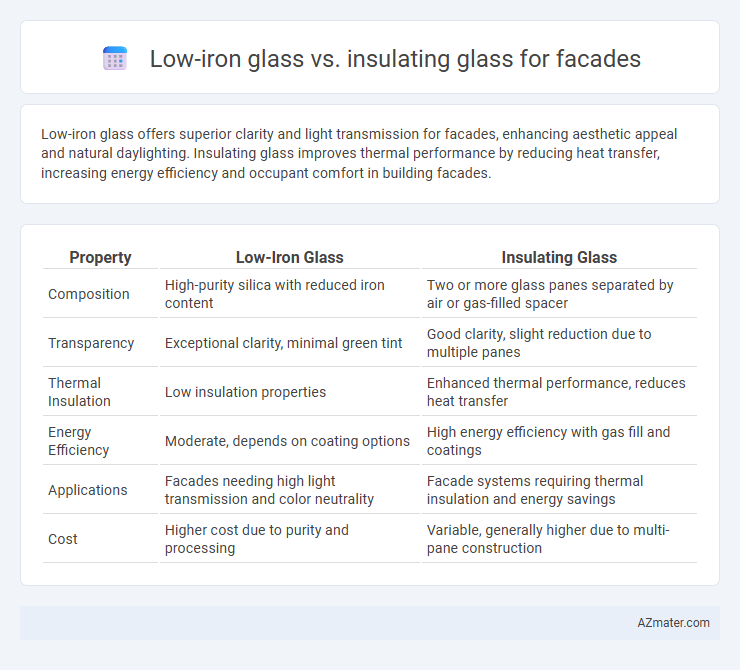Low-iron glass offers superior clarity and light transmission for facades, enhancing aesthetic appeal and natural daylighting. Insulating glass improves thermal performance by reducing heat transfer, increasing energy efficiency and occupant comfort in building facades.
Table of Comparison
| Property | Low-Iron Glass | Insulating Glass |
|---|---|---|
| Composition | High-purity silica with reduced iron content | Two or more glass panes separated by air or gas-filled spacer |
| Transparency | Exceptional clarity, minimal green tint | Good clarity, slight reduction due to multiple panes |
| Thermal Insulation | Low insulation properties | Enhanced thermal performance, reduces heat transfer |
| Energy Efficiency | Moderate, depends on coating options | High energy efficiency with gas fill and coatings |
| Applications | Facades needing high light transmission and color neutrality | Facade systems requiring thermal insulation and energy savings |
| Cost | Higher cost due to purity and processing | Variable, generally higher due to multi-pane construction |
Introduction to Glass Types in Facade Design
Low-iron glass offers exceptional clarity and a neutral color, making it ideal for enhancing natural light and aesthetics in facade design. Insulating glass consists of multiple glass panes separated by a spacer and sealed to improve thermal performance and energy efficiency in building envelopes. Combining low-iron glass with insulating units results in facades that maximize transparency while minimizing heat transfer and increasing overall building comfort.
What is Low-Iron Glass?
Low-iron glass is a type of glass specifically designed to minimize the iron content, resulting in higher clarity and enhanced light transmission compared to standard glass, making it ideal for facade applications where natural light and aesthetic clarity are priorities. Unlike insulating glass, which focuses on thermal performance through multiple layers and gas fills to reduce heat transfer, low-iron glass primarily improves visual quality and color accuracy in building exteriors. Its purer composition reduces the greenish tint inherent in ordinary glass, offering architects and builders a crisp, bright facade appearance.
What is Insulating Glass?
Insulating glass, also known as double glazing, consists of two or more glass panes separated by a sealed air or gas-filled space to reduce heat transfer and improve energy efficiency in facades. Low-iron glass is a type of clear glass with reduced iron content, offering higher light transmittance and enhanced clarity but does not provide significant thermal insulation on its own. When combined, insulating glass units with low-iron glass optimize natural daylight while maintaining superior thermal performance for building facades.
Optical Clarity: Comparing Low-Iron and Insulating Glass
Low-iron glass offers superior optical clarity with minimal green tint, enhancing natural light transmission and true color rendering in facade applications. Insulating glass, while improving thermal performance through multiple layers, may introduce slight visual distortions or reduced clarity due to the air or gas space between panes. Choosing low-iron glass ensures maximum transparency and aesthetic appeal, crucial for high-visibility building exteriors.
Thermal Performance and Energy Efficiency
Low-iron glass offers superior clarity and natural light transmission, enhancing interior brightness without significant color distortion, which complements facade aesthetics. Insulating glass improves thermal performance by incorporating multiple panes and gas fills that reduce heat transfer, effectively minimizing energy loss and optimizing building energy efficiency. Combining low-iron glass with insulating technologies can maximize both daylight quality and thermal insulation, contributing to sustainable facade design.
Aesthetic Considerations in Facade Applications
Low-iron glass offers superior clarity and minimal green tint, enhancing facade aesthetics by providing a more neutral and vibrant appearance, crucial for modern architectural designs. Insulating glass, while primarily valued for thermal performance, can incorporate low-iron layers to maintain visual appeal while improving energy efficiency in facade applications. Selecting low-iron insulating glass balances high thermal insulation with exceptional transparency, supporting both aesthetic excellence and sustainable building performance.
Cost Differences: Initial Investment and Long-term Value
Low-iron glass generally commands a higher initial investment due to its enhanced clarity and aesthetic appeal, making it a preferred choice for premium facade projects. Insulating glass, while often more affordable upfront, offers superior energy efficiency that can significantly reduce long-term operational costs through better thermal performance. Evaluating both options involves balancing the upfront expense of low-iron glass against the energy savings and potential rebates associated with insulating glass systems.
Durability and Maintenance Requirements
Low-iron glass offers higher clarity and aesthetic appeal but tends to scratch more easily than insulating glass, affecting durability over time. Insulating glass units (IGUs) provide enhanced durability due to their laminated or tempered layers, as well as superior thermal performance, reducing the frequency of maintenance. Maintenance requirements for low-iron glass involve careful cleaning to prevent surface damage, while insulating glass requires regular inspection of seals to avoid condensation and energy loss.
Environmental Impact and Sustainability
Low-iron glass offers higher clarity and natural daylight transmission, reducing the need for artificial lighting and lowering energy consumption in building facades. Insulating glass units (IGUs), composed of multiple panes separated by air or gas-filled spaces, enhance thermal insulation, significantly reducing heating and cooling energy demand. Combining low-iron glass with insulating technology maximizes energy efficiency and sustainability by minimizing carbon footprint and enhancing indoor environmental quality.
Choosing the Right Glass for Your Facade Project
Low-iron glass offers exceptional clarity and natural light transmission, making it ideal for facades where aesthetics and daylight performance are priorities. Insulating glass units (IGUs), featuring multiple glass panes separated by a spacer and sealed to improve thermal performance, reduce energy costs and enhance building comfort. Selecting between low-iron and insulating glass depends on balancing visual appeal with energy efficiency requirements for your specific facade project.

Infographic: Low-iron glass vs Insulating glass for Facade
 azmater.com
azmater.com